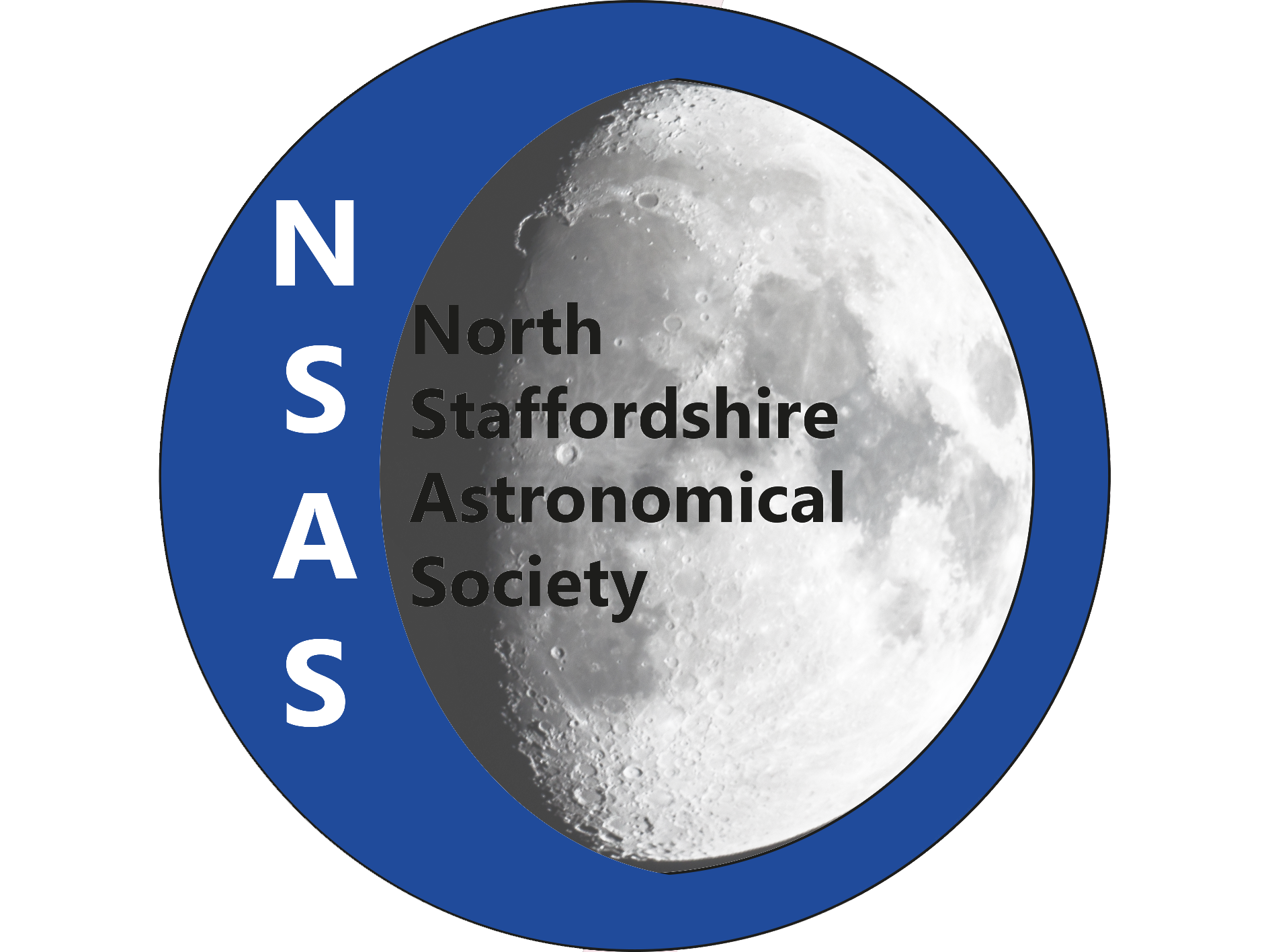Newsletter – March 2020
NEWS
Welcome to the March edition of this newsletter.
We had a good turnout for the practical evening. Unsuprisingly, rain stopped any observing but we did successfully connect Paul’s mount to his laptop so he can drive it from there.
Stargazing at Audley was also hampered by wind and rain which put paid to any observing, but the inside activites were a good substitue and we had over 50 adults and children turn up on the night, which was suprising considering the weather conditions.
Thanks must go to everyone that helped setup etc, especially Mrs Fisher for her help with refreshments and pies!


This month’s presentation is Julian Onions – The Far Side of the Moon, is it full of Aliens?
NSAS Members £FREE – Non Members £3. Further details are here.
This month’s Practical/Observing night will be on Friday 23rd March from 7pm.
If you would like to upload an image for the NSAS Members Image Gallery please follow this link
This and any other events are listed on the NSAS Events page.
May I remind everyone that the society solar scope is available throughout the winter too! It is on a monthly basis and there is just a £25 returnable deposit required. Contact me at the email below or see me at the meeting. More details here.
If anyone has any ideas for new features on the website or on any improvements you’d like to see to existing ones then please drop me an email or text.
Also keep an eye on our Facebook page as any breaking news will more than likely appear there first as I can update that from my phone.
Our new members Facebook group is here
The sky maps can be downloaded from here
Next month’s meeting is on April 7th, which is our Annual General Meeting
If anyone has anything they want to include on the website/newsletter/etc then please email me secretary@northstaffsas.co.uk
Wishing you clear skies,
Duncan
SKY EVENTS
Sky Calendar — March 2020
| 1 | Moon near the Pleiades (evening sky) at 22h UT. • The Pleiades (Wikipedia) |
| 2 | Moon near Aldebaran (evening sky) at 15h UT. • Aldebaran (Wikipedia) |
| 2 | First Quarter Moon at 19:57 UT. |
| 5 | Moon near Castor (evening sky) at 19h UT. |
| 6 | Moon near Pollux (evening sky) at 0h UT. |
| 6 | Moon near Beehive cluster M44 (evening sky) at 23h UT. • Beehive Cluster (Wikipedia) • M44: The Beehive Cluster (APOD) |
| 8 | Moon near Regulus (evening sky) at 11h UT. • Regulus (Wikipedia) |
| 9 | Full Moon at 17:47 UT. |
| 10 | Moon at perigee (closest to Earth) at 6:24 UT (distance 357,122 km; angular size 33.5′). |
| 12 | Moon near Spica (morning sky) at 1h UT. • Spica (Wikipedia) |
| 15 | Moon near Antares (morning sky) at 6h UT. • Antares (Wikipedia) |
| 16 | Last Quarter Moon at 9:35 UT. |
| 18 | Moon near Mars (morning sky) at 9h UT. Mag. 0.9. • Mars (Wikipedia) |
| 18 | Moon, Mars and Jupiter within a circle of diameter 1.6° (morning sky) at 10h UT. Mags. 0.9 and −2.1. |
| 18 | Moon near Jupiter (66° from Sun, morning sky) at 11h UT. Mag. −2.1. • Jupiter (Wikipedia) |
| 19 | Moon near Saturn (59° from Sun, morning sky) at 1h UT. Mag. 0.7. • Saturn (Wikipedia) |
| 20 | Vernal equinox at 3:54 UT. The time when the Sun reaches the point along the ecliptic where it crosses into the northern celestial hemisphere marking the start of spring in the Northern Hemisphere and autumn in the Southern Hemisphere. • Vernal Equinox (Wikipedia) |
| 20 | Mars 0.7° S of Jupiter (67° from Sun, morning sky) at 11h UT. Mags. 0.9 and −2.1. |
| 21 | Moon near Mercury (28° from Sun, morning sky) at 21h UT. Mag. 0.3. • Mercury (Wikipedia) |
| 24 | Mercury at greatest elongation west (28° from Sun, morning sky) at 2h UT. Mag. 0.3. |
| 24 | New Moon at 9:28 UT. Start of lunation 1203. • Lunation Number (Wikipedia) |
| 24 | Moon at apogee (farthest from Earth) at 15h UT (distance 406,692 km; angular size 29.4′). |
| 24 | Venus at greatest elongation east (46° from Sun, evening sky) at 22h UT. Mag. −4.4. |
| 28 | Moon near Venus (evening sky) at 16h UT. Mag. −4.4. • Venus (Wikipedia) |
| 29 | Moon near the Pleiades (evening sky) at 4h UT. • The Pleiades (Wikipedia) |
| 29 | Moon near Aldebaran (evening sky) at 22h UT. • Aldebaran (Wikipedia) |
| 31 | Mars 0.9° SE of Saturn (morning sky) at 18h UT. Mags. 0.8 and 0.7. |
| All times Universal Time (UT). | |
Astronomers detect biggest explosion in the history of the Universe
- Date:
- February 27, 2020
- Source:
- International Centre for Radio Astronomy Research
- Summary:
- Scientists studying a distant galaxy cluster have discovered the biggest explosion seen in the Universe since the Big Bang. The blast came from a supermassive black hole at the centre of a galaxy hundreds of millions of light-years away. It released five times more energy than the previous record holder.
- Share:

Scientists studying a distant galaxy cluster have discovered the biggest explosion seen in the Universe since the Big Bang.
The blast came from a supermassive black hole at the centre of a galaxy hundreds of millions of light-years away.
It released five times more energy than the previous record holder.
Professor Melanie Johnston-Hollitt, from the Curtin University node of the International Centre for Radio Astronomy Research, said the event was extraordinarily energetic.
“We’ve seen outbursts in the centres of galaxies before but this one is really, really massive,” she said.
“And we don’t know why it’s so big.
“But it happened very slowly — like an explosion in slow motion that took place over hundreds of millions of years.”
The explosion occurred in the Ophiuchus galaxy cluster, about 390 million light-years from Earth.
It was so powerful it punched a cavity in the cluster plasma — the super-hot gas surrounding the black hole.
Lead author of the study Dr Simona Giacintucci, from the Naval Research Laboratory in the United States, said the blast was similar to the 1980 eruption of Mount St. Helens, which ripped the top off the mountain.
“The difference is that you could fit 15 Milky Way galaxies in a row into the crater this eruption punched into the cluster’s hot gas,” she said.
Professor Johnston-Hollitt said the cavity in the cluster plasma had been seen previously with X-ray telescopes.
But scientists initially dismissed the idea that it could have been caused by an energetic outburst, because it would have been too big.
“People were sceptical because the size of outburst,” she said. “But it really is that. The Universe is a weird place.”
The researchers only realised what they had discovered when they looked at the Ophiuchus galaxy cluster with radio telescopes.
“The radio data fit inside the X-rays like a hand in a glove,” said co-author Dr Maxim Markevitch, from NASA’s Goddard Space Flight Center.
“This is the clincher that tells us an eruption of unprecedented size occurred here.”
The discovery was made using four telescopes; NASA’s Chandra X-ray Observatory, ESA’s XMM-Newton, the Murchison Widefield Array (MWA) in Western Australia and the Giant Metrewave Radio Telescope (GMRT) in India.
Professor Johnston-Hollitt, who is the director of the MWA and an expert in galaxy clusters, likened the finding to discovering the first dinosaur bones.
“It’s a bit like archaeology,” she said.
“We’ve been given the tools to dig deeper with low frequency radio telescopes so we should be able to find more outbursts like this now.”
The finding underscores the importance of studying the Universe at different wavelengths, Professor Johnston-Hollitt said.
“Going back and doing a multi-wavelength study has really made the difference here,” she said.
Professor Johnston-Hollitt said the finding is likely to be the first of many.
“We made this discovery with Phase 1 of the MWA, when the telescope had 2048 antennas pointed towards the sky,” she said.
“We’re soon going to be gathering observations with 4096 antennas, which should be ten times more sensitive.”
“I think that’s pretty exciting.”
Story Source:
Materials provided by International Centre for Radio Astronomy Research.
Regular Meetings
Practical/Observing Evening
CANCELLED
